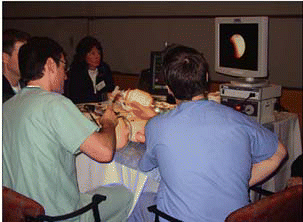Funding for validation studies remains otolaryngology’s stumbling block. Even after joining forces, Montefiore, NYU Medical Center, and New York Eye and Ear Infirmary cannot scrape together the approximately $15 million in funding required to validate simulations at the level required for inclusion in board certification. Support from the American College of Surgeons and the American Association of Neurological Surgeons hasn’t gotten them over the hump either. Governmental and private foundation funding sources have currently dried up.
Explore This Issue
September 2008Partnering with commercial vendors of otolaryngologic simulators has potential, but those vendors face a chicken-and-egg conundrum. They need committed customers before spending millions on developing sophisticated surgical simulations. Lockheed Martin Corporation, which, in the 1980s developed Martin, the first ESS simulator, exited the field after having built only four systems. Montefiore’s Dr. Fried, one of Martin’s first users, is now working with physicians and vendors associated with the VOXEL-MAN project, headquartered at the University Medical Center at Hamburg-Eppendorf, on finding a cost-effective way to build a new ESS simulator. We’re getting to the point where ENT simulations will be commercially viable. It may take five years but the potential is there. The stakes are high in both temporal bone and sinus surgery because of patient safety issues, he said.

Despite funding shortfalls, otolaryngologists-head and neck surgeons are embracing medical simulation. Students and teachers recognize it as a powerful new teaching tool, and surgical residents and experienced physicians are using it to hone or refresh their OR skills and prepare for delicate surgeries. As large hospitals and academic medical centers build their own simulation centers, they will draw on the expertise of their clinicians, administrators, social scientists, engineers, and IT departments to develop new tools and applications for medical simulation.
Medical Simulation Would Reduce Surgical Errors
- Screen surgical residents for demonstrable aptitude.
- Provide initial training in surgical experiences.
- Promote ongoing training of surgeons through consistently reproducible processes.
- Enable periodic assessment of acquired surgical skills.
- Maintain proficiency through rehearsal of complex, patient-specific procedures.
Source: Healy GB. The College should be instrumental in adapting simulators to education. Bull Am Coll Surg 2002;87:10.
©2008 The Triological Society
Leave a Reply